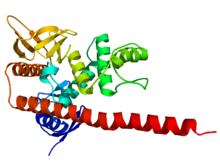The ERM protein family consists of three closely related proteins, ezrin,[2] radixin[3]and moesin.[4][5] The three paralogs, ezrin, radixin and moesin, are present in vertebrates, whereas other species have only one ERM gene. Therefore, in vertebrates these paralogs likely arose by gene duplication.[6]
ERM proteins are highly conserved throughout evolution. More than 75% identity is observed in the N-terminal and the C-terminal of vertebrates (ezrin, radixin, moesin), Drosophila (dmoesin) and C. elegans (ERM-1) homologs.[7]
| Ezrin/radixin/moesin family | |||
|---|---|---|---|
 | |||
| Identifiers | |||
| Symbol | ERM | ||
| Pfam | PF00769 | ||
| InterPro | IPR011259 | ||
| SCOP2 | 1ef1 / SCOPe / SUPFAM | ||
| |||
ERM proteins crosslink actin filaments with plasma membranes. They co-localize with CD44 at actin filament-plasma membrane interaction sites, associating with CD44 via their N-terminal domains and with actin filaments via their C-terminal domains.[5][8]
The ERM protein moesin directly binds to microtubules via its N-terminal FERM domain in vitro and stabilizes microtubules at the cell cortex in vivo. This interaction is required for specific ERM-dependent functions in mitosis.[9]
The current model for ERM proteins activation is a two-steps mechanism:[11]
- First, phosphatidylinositol 4,5-bisphosphate interaction at the plasma membrane induces a pre-opening of ERM molecule
- Then, a not yet identified kinase phosphorylates a Threonine localized in a highly conserved region of the C-terminal domain. The phosphate will stabilize the opening of the molecule.
https://en.wikipedia.org/wiki/ERM_protein_family
No comments:
Post a Comment